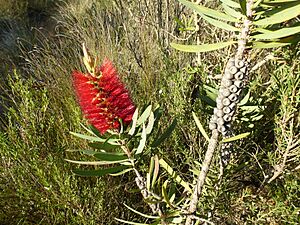Albany bottlebrush facts for kids
Quick facts for kids Albany bottlebrush |
|
|---|---|
 |
|
| M. glauca in Gull Rock National Park. | |
| Scientific classification | |
| Genus: |
Melaleuca
|
| Species: |
glauca
|
| Synonyms | |
|
|
The Albany bottlebrush (scientific name: Melaleuca glauca) is a beautiful plant found only in the southwest part of Western Australia. It belongs to the myrtle family, called Myrtaceae. This plant is known for its tall, shrubby shape and its striking red flowers that look like bottlebrushes. It blooms in spring and is a native plant to this area.
Contents
What it Looks Like
The Albany bottlebrush is a shrub that can grow up to about 3.5 meters (11 feet) tall. It has tough, fibrous bark. Its leaves are arranged one after another along the stem. They are usually between 40 and 128 millimeters (1.6 to 5 inches) long and 3 to 18 millimeters (0.1 to 0.7 inches) wide. The leaves are flat and often shaped like a narrow egg. They have a main vein down the middle and many smaller veins branching out.
The flowers are a bright red color. They grow in spikes at the ends of the branches. These spikes can be up to 75 millimeters (3 inches) wide and have 20 to 120 or more individual flowers on each spike. The petals of the flowers are about 4.5 to 7.2 millimeters long. They fall off as the flower gets older. Inside each flower, there are five groups of stamens (the parts that produce pollen). Each group has between 6 and 15 stamens.
Albany bottlebrush flowers from October to December. After the flowers bloom, they turn into woody capsules, which are like small seed pods. These capsules are about 5.7 to 8.8 millimeters (0.2 to 0.3 inches) long.
How it Got its Name
The Albany bottlebrush was first officially described in 1830 by an English botanist named Robert Sweet. He first named it Callistemon glaucus. Later, in 2013, another botanist named Lyndley Craven changed its name to Melaleuca glauca. This new name was published in a book about Melaleuca plants.
The second part of the scientific name, glauca, comes from a Latin word meaning "glaucous". This describes the leaves, which have a slightly dull, blue-green, or grayish-white color.
Where it Grows
The Albany bottlebrush is found in the southern and southwestern coastal areas of Western Australia. It grows between the cities of Perth and Albany, Western Australia. You can find it in areas like the Jarrah Forest, Swan Coastal Plain, and Warren regions. It prefers to grow in wet or swampy ground, often in sandy or clay soils.
Conservation Status
The Government of Western Australia's Department of Parks and Wildlife has listed Melaleuca glauca as "not threatened." This means it is not currently at risk of disappearing.
Using it in Gardens
The Albany bottlebrush is a popular plant to grow in gardens, especially in warmer parts of Australia. People often grow it for its beautiful red flowers. It is usually sold under its older name, Callistemon glaucus, in plant nurseries.
See also
 In Spanish: Callistemon glaucus para niños
In Spanish: Callistemon glaucus para niños


